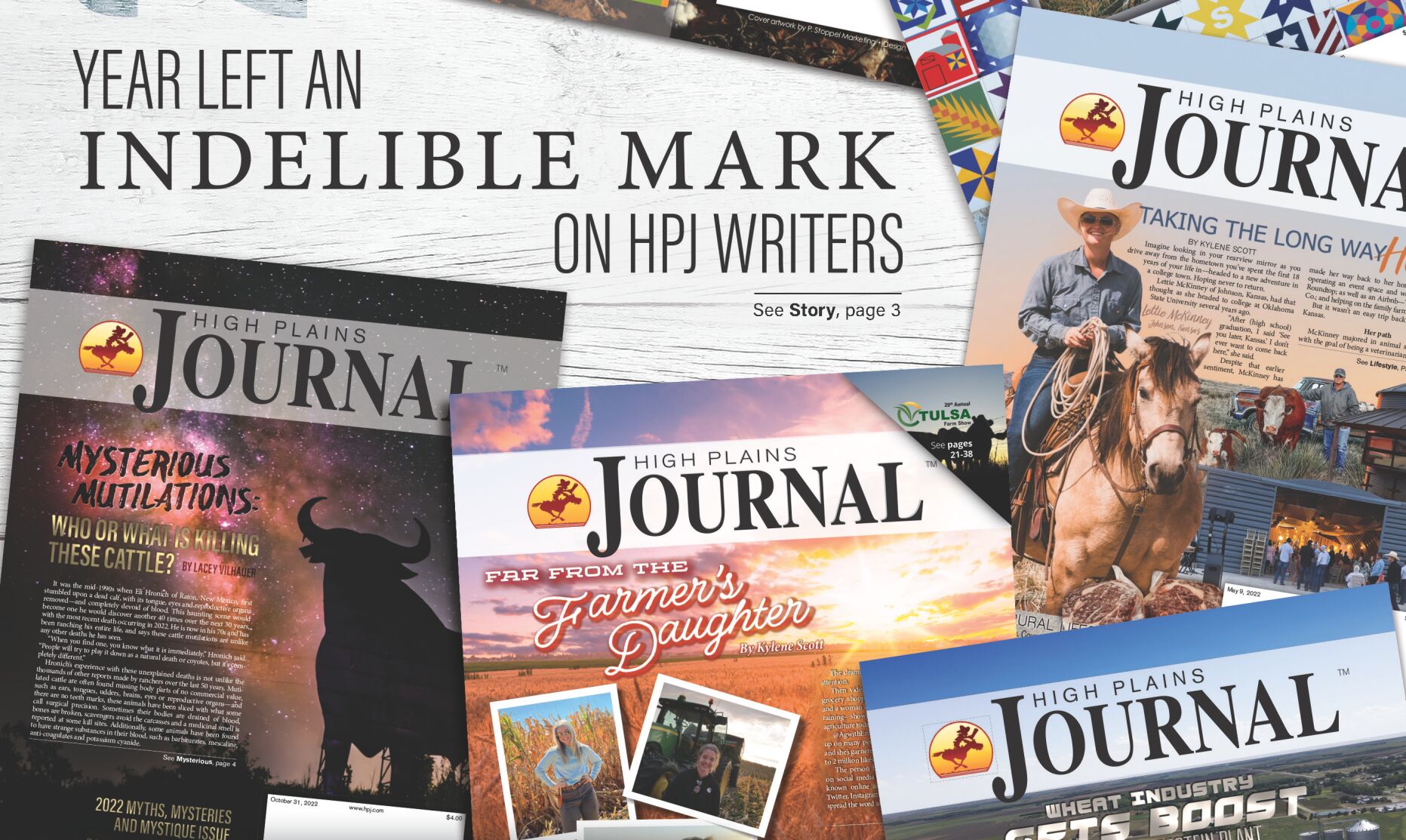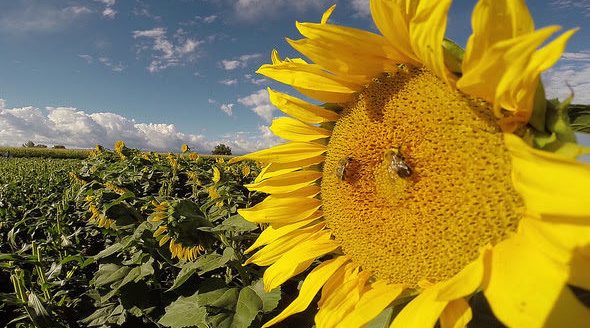The end of the year reminds farmers and ranchers and their families about accomplishments, and they can take pride whether it was a major expansion or less intrinsic but just as valuable.
We’ve asked the editors and writers at High Plains Journal to share with readers a favorite story. As we assembled this piece we could see the diversity in their choices. We hope you enjoy their perspective.
“Barn quilts color the countryside and reflect rural heritage”
By Shauna Rumbaugh
Whether a warm blanket crocheted by Great-Grandma, a wooden toy crafted for the grandkids by Grandpa, or a painted heirloom wrapped and placed under the Christmas tree, art and handicrafts are an important part of our rural history. Rural art reflects how resourceful and creative rural people can be even as they focus on the more technical, practical aspects of running a farm or ranch.
My favorite story I wrote in 2022 was the June 20 Agricultural Arts and Festivals cover story, “Barn quilts color the countryside and reflect rural heritage.” I wish I could have interviewed the late Donna Sue Groves, who inspired the barn quilt trail movement with her vision of a “clothesline” of barn quilts stretching across the country. I enjoyed talking to Suzi Parron and Sandi Lawson about Groves’ legacy as I learned more about the history of barn quilts, trails, and traditional quilt block patterns.
The cover artwork for that story is also my favorite design by talented graphic designer Diana Derstein, who retired from High Plains Journal this summer. That cover featured Kansas’ Largest Barn Quilt in Ashland—a 30-foot by 16-foot collage made up of individual quilt squares painted by Clark County community members.
Ashland now has competition elsewhere in Kansas for the state’s largest barn quilt record. Since my story was published, the RoCo Arts Council in Rooks County completed the first phase of its barn quilt wall project, which features 135 quilt squares combined into a mural in Stockton. A barn quilt mural was also constructed in Seneca with the help of a grant from the Kansas Department of Commerce’s Office of Rural Prosperity.
I appreciate how these communities are combining the creative talents of residents of all ages to brighten up downtown spaces. I look forward to seeing more barn quilts and murals pop up across rural America.
Shauna Rumbaugh can be reached at 620-227-1805 or [email protected].
By Jennifer Theurer
My favorite story of 2022 was “Hedging his bets” that I wrote about James Anderson of Anderson Farm Enterprise LLC in Galva, Kansas.
Not only is he an innovator but he is also a young farmer doing the best he can for his family and his land. He’s also from the area where I grew up so that was an added bonus.
During the interview, we walked around his parents’ farm looking at the equipment he has built and modified over the years. Getting to see his thought process in-person was a treat for me because it showed just how passionate he is about conserving the land and all that grows from it. I appreciate his taking the time to visit with me and sharing a small part of his story. I have no doubt he will succeed.
Jennifer Theurer can be reached at 620-227-1858 or [email protected].
By Lacey Vilhauer
Sign up for HPJ Insights
Our weekly newsletter delivers the latest news straight to your inbox including breaking news, our exclusive columns and much more.
My favorite story I wrote this year was titled, “Mysterious Mutilations: Who or what is killing these cattle?” The article was published on Oct. 31 and since it was the cover story of the Myths, Mysteries and Mystique issue of High Plains Journal, I was excited to feature a topic with a macabre feel that is not commonly seen in the pages of HPJ.
Several years ago, a reader from Colorado called me to ask questions about a recent story I had written and during our conversation, he brought up the topic of cattle mutilations, which he had experienced with his cow-calf operation. I had written down the idea for a future article, but an opportunity never arose until the editorial department decided to have a mystery issue and I thought this was the perfect occasion to cover this topic.
I started researching the subject several months earlier than usual because I recognized the need for informed, reputable sources and strong facts to back up a controversial theme. I contacted Chris O’Brien, a mutilation researcher and author, who is heavily featured in the story. After his interview, he put me in touch with David Perkins, his mentor, and I conducted another fascinating interview with him.
My goal with this story was keep the reader engaged in an intriguing article by weaving through the incredible realities of these mutilations with a neutral overall angle, leaving the audience with their own opinion of the cause or culprit of these deaths. Secondly, I wanted to reinforce that ranchers are victims in these cases and regardless of who or what are killing the cattle, the producers continue to suffer real losses. After the story was published, a number of readers called me to report their own strange mutilations cases, so the article seemed resonate with many ranchers who have experience with mutilations or have wondered what is at the root of these bizarre cases.
Lacey Vilhauer can be reached at 620-227-1871 or [email protected].
"Far from the farmer’s daughter”
By Kylene Scott
Tasked with picking my favorite story of 2022, I found it only fitting to pick two. First it was my Rural Lifestyle cover story from May 9, “Taking the long way home,” which features Lettie McKinney and her passel of diversified businesses in rural far western Kansas. Second was a more recent one, the cover story from Nov. 28’s Women in Ag issue, which featured Emma Seamons in “Far from the farmer’s daughter.”
Both of these young women were a breath of fresh air. Witty, spunky and a dream to interview, they could have talked all day long and wouldn’t have run out of topics to discuss.
McKinney and her desire to strengthen the opportunities in her hometown of Johnson, Kansas, after being away from home for a number of years is inspiring. She has a lot of irons in the fire but is finding a way to make things work on her family’s operation.
Seamons, better known in her social media channels as @agwithemma, has a way to draw people into her videos and help them take note of agriculture. So far she’s gathered 117.8 thousand followers and has 2.4 million likes on TikTok alone.
I sure hope these talented gals continue to succeed in their endeavors. Support them if you can.
Kylene Scott can be reached at 620-227-1804 or [email protected].
“Tough lessons for cotton growers from this year’s drought and heat”
By David Murray
I get to work on a lot of fascinating stories on all kinds of topics. But my favorite one this past year was my interview with cotton farmer Ricky Yantis about the effects of the long drought on this year’s cotton harvest in the Texas cotton patch.
There’s no one like a farmer for explaining the ins and outs of his or her business. Yantis did an incredible job of explaining things like how the soil in his area has to be broken up by special machines due to the dry winds; which cover crops help the soil; and why it takes a while for the true cotton yield to be calculated. Yantis created a close-up and detailed picture of all the challenges he has to deal with, and I hope I communicated that to my readers.
David Murray can be reached at [email protected].
“Wheat industry gets boost from biofuel, protein plant”
By Dave Bergmeier
As farmers and ranchers weathered through a difficult year—drought that cut dryland crops and reduced forage capacity—there were bright spots.
One of mine was to do a cover story about a new wheat-processing center that will be completed in summer 2023 in my hometown of Phillipsburg, Kansas.
The optimism for a plant that will mean added value is important to the wheat industry. The plant will produce wheat-based biofuel for the energy sector and wheat protein for bakers and pet food manufacturers, according to Amber Wave CEO Randy Cimorelli in a story that ran Oct. 17. The location for the plant is ideal because it has historically been in the heart of wheat production. The Amber Wave plant will also use connections with Kansas State University, seed companies, grower organizations and farmers to produce protein that is beneficial for Amber Wave’s needs while also benefiting growers.
“Ultimately, we can reward higher protein levels,” Amber Wave CEO Randy Cimorelli said.
The plant, when fully operational, will employ 85 employees and produce 50 million gallons a year and process 20 million bushels of wheat a year. It’s the kind of news we can all take pride in.
Dave Bergmeier can be reached at 620-227-1822 or [email protected].



